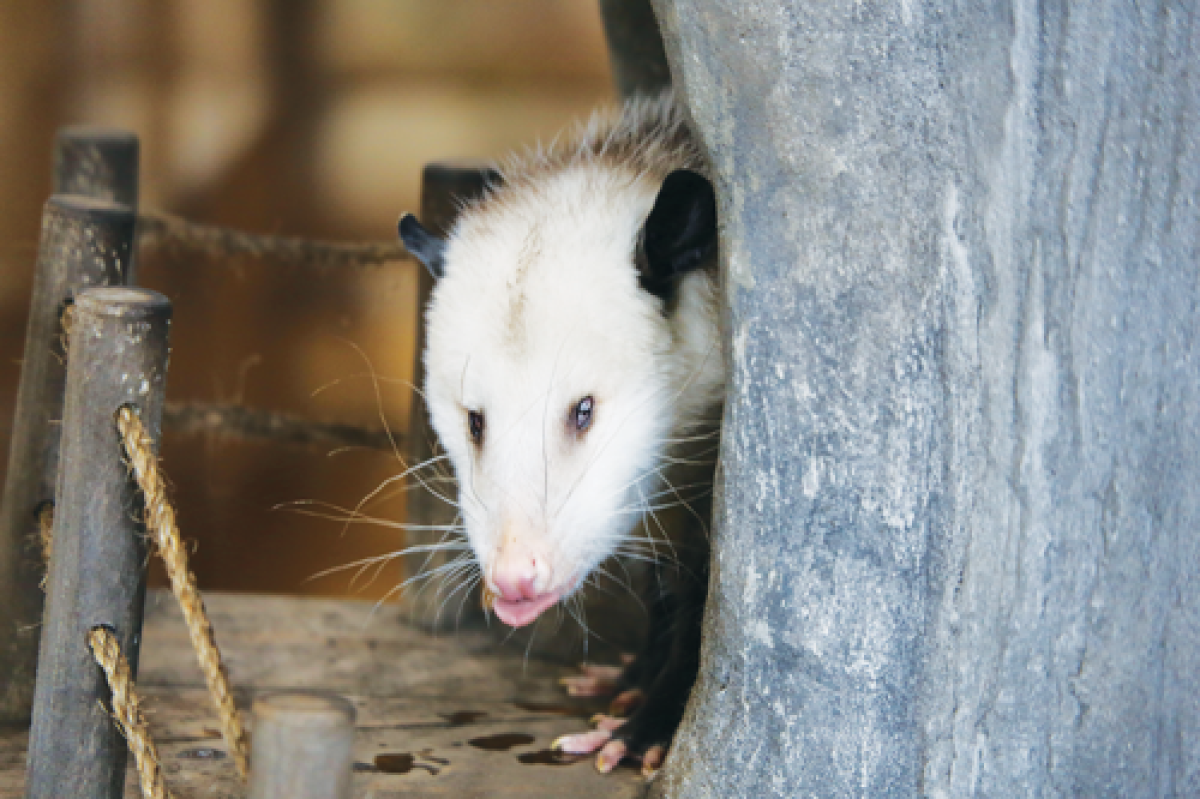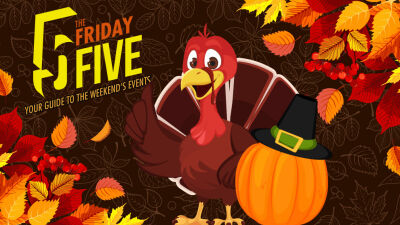METRO DETROIT — On a cool late March morning, one of Shelby Township’s newest residents stumbled his way out of bed.
Murray the opossum, resident of the Burgess-Shadbush Nature Center and a local celebrity of note, lives a life unlike that of his peers. He lives in a bespoke enclosure built by a local Eagle Scout for the nature center’s prior resident opossum and sleeps within an artificial tree, receiving artfully crafted meals. Though Murray was born without eyes, the only thing slowing him down from his breakfast of kale — a personal favorite — and vegetables is his own strength to push through the morning grogginess and be on his way.
Despite the relatively lavish living arrangements, not much separates Murray from the possibly hundreds of thousands of other opossums in the metro Detroit region. Conversely, Murray and all those other opossums have a lot more in common with kangaroos than the rodents some may say opossums resemble.
“Opossums are Michigan’s only marsupial — in fact, the only marsupial found in North America,” said Elizabeth Schultz, nature center coordinator. “Marsupials are any mammals where mom has a pouch where she carries her babies, called ‘joeys.’ They’re kind of like Michigan’s kangaroo.”
Michigan tends to be in the upper range of where opossums are found because they are not particularly suited for cold weather. Opossums have been in North America since prehistoric times and found suitable habitats in the millennia that followed. As ancient forests have given way to farms and urban development, opossums have weathered the changes by focusing on scavenging as their main mode of living.
“They have a really important role in our ecosystem,” Schultz said. “They’re kind of like our trash cleanup crew. They go around and they find the dead animals or rotting foods and they’ll eat them. They’ll catch live food, too, but they’re not the best hunters. They’re not going after people’s chickens or anything. Sometimes, they might get into a coop and go after the eggs, but they’re not very fast (and) not the brightest of animals, so really, they’re just finding dead things to eat.”
The omnivorous diet of opossums means they can virtually eat any organic material they come across. At Burgess-Shadbush, Murray’s meals often include a balance of greens and meats, the latter ranging from cat kibble to whole prey like mice and chicks. In the wild, this means they’ll eat anything they come across that is not too hard to pin down — including residential trash, which is where many Michiganders run into them.
“A lot of times people tell me they open their back door, and they see an opossum, and it opens its mouth wide, and it hissed, and they were so scared, and they ran back inside,” Schultz said. “And I always tell them that is exactly what the opossum wants! They’re all about intimidation; they would never actually come after you. They would open their mouth, they hiss, and they try to just be super scary looking.”
Should an opossum fail to scare predators away, the scavenger turns to the second trick in its acting repertoire — playing dead. When in the throes of danger, the toothy thespians get overwhelmed, faint and begin oozing a foul-smelling liquid from their mouth and butt to dupe predators into thinking they’re diseased so they move on. The “acting” can last for around 10-15 minutes before the opossum regains consciousness and resumes its scavenging.
Ironically, given the scented ooze trick, opossums are fairly resistant to diseases. They have too high of a body temperature to become infected by rabies, though they can still carry the virus.
Opossums are constantly on the go to scavenge — even joeys begin scavenging as soon as they fall off their mothers, no learning required — and that regularly brings them around to residential areas. While they pose minimal threats to humans and pets, their presence can be unwanted. An opossum will leave an area quickly if they cannot find any food, so the best way to avoid them knocking on your door (or rather getting into your trash bags) is to not give them a reason to bother.
“They’re not trying to be harmful; they’re not trying to attack anything. They’re just trying to find food and move on,” Schultz said. “If you don’t want an opossum in your backyard, make sure you’re covering all food sources, you’re not leaving cat food out (and) the dog food is covered. They’ll eventually move on. Just have patience.”
With human society providing so many good food sources for opossums, it is all too common for interactions between humans and opossums to turn lethal. Drivers striking opossums crossing the road, opossums getting caught or poisoned by rodent traps and pets of humans, like cats and dogs, attacking wandering opossums have all led to many situations where opossums become injured and, if left alone, die. Cynthia Russ, owner of the Motor City Possum Rescue and a Michigan Department of Natural Resources certified rehabilitator, says she receives about a dozen calls a week during the mating seasons of late winter and early spring.
When injured opossums are brought to her Ferndale-based mammal rehabilitation operation, Russ says opossums are some of the easier to handle animals she treats.
“They’re not as aggressive,” Russ said. “Most of the time they’ll hiss at you and show all their scary teeth, but they don’t lunge or chase you. I’m more nervous about handling squirrels than I am anything, because they’re so quick and they can puncture your hand. (Squirrels) can crack a walnut with their teeth, so they can easily break your finger. But opossums are pretty docile. They look scary, way scarier than they are.”
When a dead opossum mother is brought to her, the goal is to get the joeys out of their pouch and onto bottled milk. Once grown to about a half pound, the joeys are released and returned to the wild. In rare cases when an opossum may be unfit to be returned to the wild, it is possible they may be relocated to wildlife centers such as Burgess-Shadbush, as was the case with Murray.
Ways to avoid needlessly tempting the fates of opossums include not littering so they are not attracted to roads, slowing down to give opossums a chance to flee if one is spotted while driving and covering rodent traps so opossums are less likely to get caught by them.
“I feel like people just have to learn to coexist and understand that (opossums) are not a threat,” Russ said. “They’re not going to hurt your dog. They’re not going to hurt your cat. They’re not going to attack anything because they’re not aggressive and they’re actually beneficial.”
Schultz expects the opossum population of Michigan to remain well all things considered, given their scavenging nature and the wide availability of food sources across the region. However, she notes that opossums are likely to serve as an indicator species regarding problems elsewhere in the ecosystem.
“They eat a lot of amphibians, frogs and toads, so if we’re not being careful and there’s pollution in water that affects the frogs and amphibians and even fish, that could affect the opossums,” Schultz said. “Another thing to consider is that there is a lot of fear in southeast Michigan about coyotes, but coyotes keep the opossum and raccoon populations under control. Areas that have too many opossums and raccoons will actually have fewer birds, studies have shown, because both eat bird eggs. As we continue to grow the many suburbs around here and expand our cities, just making sure we’re acknowledging that there are other animals out there. They don’t want to have anything to do with us. They’re just trying to survive.”
Though opossums are not known to be particularly friendly, Murray and other animals can be visited at the Burgess-Shadbush Nature Center on Wednesdays through Saturdays from 10 a.m. to 6 p.m. and on Sundays from noon to 5 p.m. More information about the nature center can be found on shelbytwp.org under the “government,” “departments” and “parks and recreation” tabs.
 Publication select ▼
Publication select ▼























